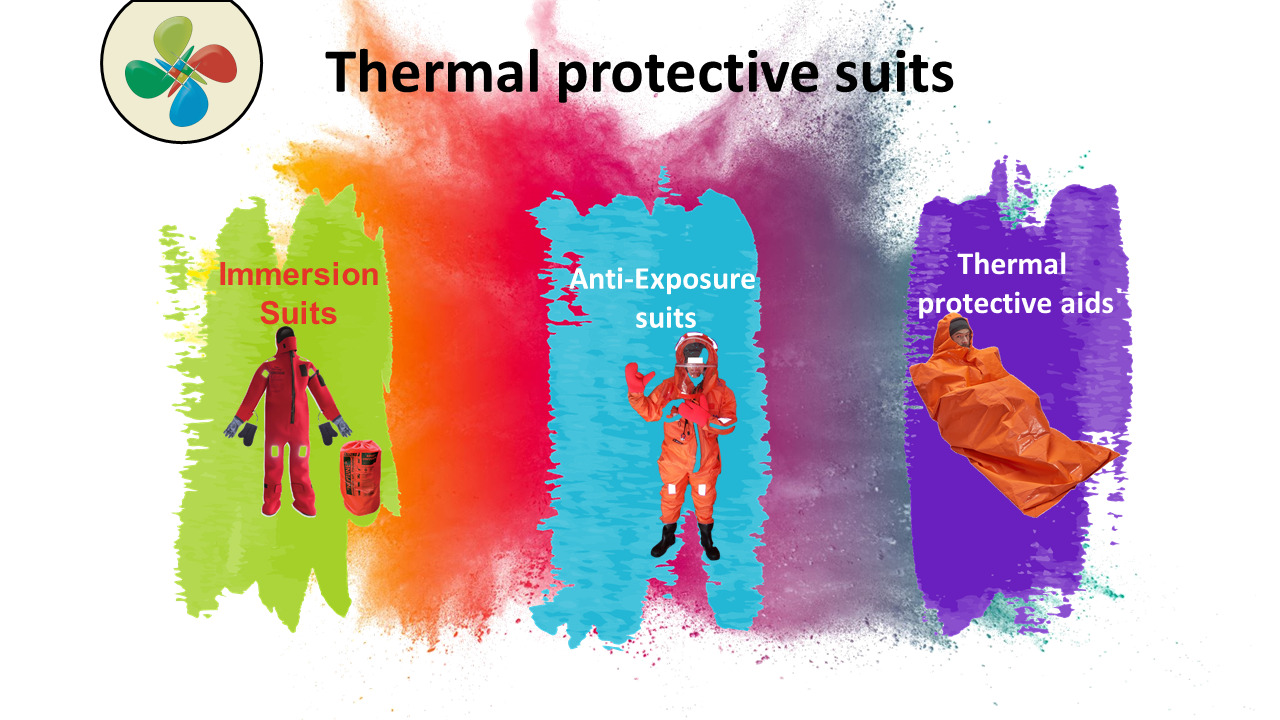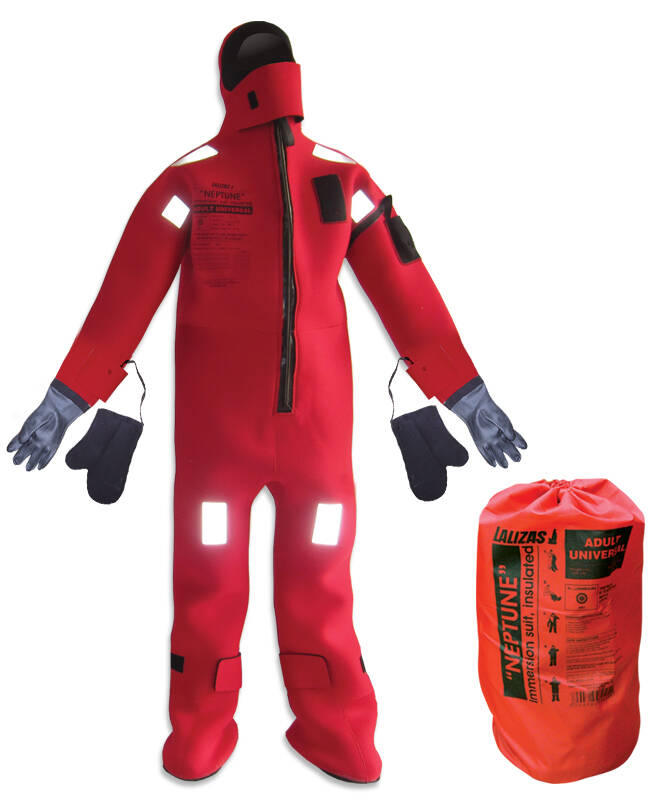Thermal protective suits

Thermal protective suits
The immersion suit
 The immersion suit shall be constructed with waterproof materials such that:
The immersion suit shall be constructed with waterproof materials such that:
- Thermal protective suits
- It can be unpacked and donned without assistance within 2 min, taking into account any associated clothing, and a life-jacket if the immersion suit is to be worn in conjunction with a life-jacket;
- It will not sustain burning or continue melting after being totally enveloped in a fire for a period of 2 seconds;
- It will cover the whole body with the exception of the face. Hands shall also be covered unless permanently attached gloves are provided;
- It is provided with arrangements to minimize or reduce free air in the legs of the suit;
- Following a jump from a height of not less than 4.5 m into the water there is no undue ingress of water into the suit. An immersion suit which also complies with the requirements of life-jackets may be classified as a life-jacket.
- An immersion suit which has buoyancy and is designed to be worn without a life-jacket shall be fitted with a light and the whistle complying with the requirements for life-jackets.
- If the immersion suit is to be worn in conjunction with a life-jacket, the life-jacket shall be worn over the immersion suit. A person wearing such an immersion suit shall be able to don a life-jacket without assistance.
In that case immersion suit shall permit the person wearing it:
- To climb up and down a vertical ladder at least 5 m in length;
- To perform normal duties associated with abandonment;
- To jump from a height of not less than 4.5 m into the water without damaging or dislodging the immersion suit, or being injured;
- To swim a short distance through the water and board a survival craft.
An immersion suit made of material which has no inherent insulation shall be:
- marked with instructions that it must be worn in conjunction with warm clothing;
- so constructed that, when worn in conjunction with warm clothing, and with a life-jacket if the immersion suit is to be worn with a life-jacket, the immersion suit continues to provide sufficient thermal protection, following one jump by the wearer into the water from a height of 4.5 m, to ensure that when it is worn for a period of 1h in calm circulating water at a temperature of 5°C, the wearer’s body core temperature does not fall more than 2°C.
An immersion suit made of material with inherent insulation, when worn either on its own or with a life-jacket, if the immersion suit is to be worn in conjunction with a life-jacket, shall provide the wearer with sufficient thermal insulation, following one jump into the water from a height of 4.5 m, to ensure that the wearer’s body core temperature does not fall more than 2°C after a period of 6h immersion in calm circulating water at a temperature of between 0°C and 2°C.
A person in fresh water wearing either an immersion suit or an immersion suit with a life-jacket, shall be able to turn from a face-down to a face-up position in not more than 5 seconds.
Anti-Exposure suits
 The anti-exposure suit shall be constructed with waterproof materials such that it:
The anti-exposure suit shall be constructed with waterproof materials such that it:
- Thermal protective suit
- provides inherent buoyancy of at least 70 N;
- is made of material which reduces the risk of heat stress during rescue and evacuation operations;
- covers the whole body with the exception of the head and hands and, where the Administration so permits, feet; gloves and a hood shall be provided in such a manner as to remain available for use with the anti-exposure suits;
- can be unpacked and donned without assistance within 2 min;
- does not sustain burning or continue melting after being totally enveloped in a fire for a period of 2 seconds;
- is equipped with a pocket for a portable VHF telephone;
- has a lateral field of vision of at least 120°.
An anti-exposure suit which also complies with the requirements of life-jackets may be classified as a life-jacket.
An anti-exposure suit shall permit the person wearing it:
- to climb up and down a vertical ladder of at least 5 m in length;
- to jump from a height of not less than 4.5 m into the water with feet first, without damaging or dislodging the suit, or being injured;
- to swim through the water at least 25 m and board a survival craft;
- to don a life-jacket without assistance; and
- to perform all duties associated with abandonment, assist others and operate a rescue boat.
- An anti-exposure suit shall be fitted with a light complying with the requirements for life jackets.
An anti-exposure suit shall:
- if made of material which has no inherent insulation, be marked with instructions that it must be worn in conjunction with warm clothing;
- be so constructed, that when worn as marked, the suit continues to provide sufficient thermal protection following one jump into the water which totally submerges the wearer and shall ensure that when it is worn in calm circulating water at a temperature of 5°C, the wearer’s body core temperature does not fall at a rate of more than 1.5°C per hour, after the first 0.5 hours.
A person in fresh water wearing an anti-exposure suit complying with the requirements of this section shall be able to turn from a face- down to a face-up position in not more than 5 seconds and shall be stable face-up. The suit shall have no tendency to turn the wearer face-down in moderate sea condition.
Thermal protective aids
 Thermal protective suit. A thermal protective aid shall be made of waterproof material having a thermal conductance of not more than 7800 W/(m2.K) and shall be so constructed that, when used to enclose a person, it shall reduce both the convective and evaporating heat loss from the wearer’s body.
Thermal protective suit. A thermal protective aid shall be made of waterproof material having a thermal conductance of not more than 7800 W/(m2.K) and shall be so constructed that, when used to enclose a person, it shall reduce both the convective and evaporating heat loss from the wearer’s body.
The thermal protective aid shall:
- cover the whole body of persons of all sizes wearing a life-jacket with the exception of the face. Hands shall also be covered unless permanently attached gloves are provided;
- be capable of being unpacked and easily donned without assistance in a survival craft or rescue boat;
- permit the wearer to remove it in the water in not more than 2 min, if it impairs ability to swim.
- function properly throughout an air temperature range -30°C to +20°C.


